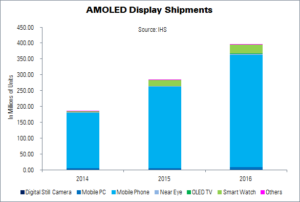While LCD remains the dominant display technology today, IHS predicts that AMOLED shipments will climb 40% this year, to 395 million units. At the same time, revenues will rise 25%, to $15 billion. Falling costs, wider adoption in end-user electronics and the ramp-up of new manufacturing facilities are contributing to the shift.
“AMOLED has a simpler structure than LCD, as well as a thinner and lighter form factor, better colour saturation, greater contrast ratio, faster response time and easier integration with touch functions,” said David Hsieh of IHS. “In addition, AMOLED is formed on a polymer base substrate, allowing it to be flexible, bendable and even foldable. The organic electro-luminescence materials can be formed using a soluble printing process, which means AMOLED has the potential to be produced at a very low cost.”
OLED technology has faced multiple barriers to adoption, largely revolving around manufacturing. Many of these were resolved in 2015 (although blue materials still suffer from a short lifetime), and OLED is beginning to find its niche (although it is a large one! – TA). Adoption is rising quickly.
Samsung has been using AMOLED displays for several years, and since the second half of 2015 other smartphone brands – largely but not always in China – have gone the same way. 5″ 1280 x 720, 5.5″ 1920 x 1080 and 5.5″ and 6″ 2560 x 1440 panels will be the major AMOLED smartphone display drivers this year.
IHS expects AMOLED penetration in smartphones to climb from 17% in 2015 to 21% this year. If Apple were to replace its current LTPS LCD displays with AMOLED, as rumoured, the transition will dramatically increase that figure – and “will be viewed as a milestone in flexible form factor development”, according to Hsieh.
Smartphones are not the only application for AMOLED. OLED TV shipments will grow further in 2016, thanks to process improvements and enhancements to production efficiency, as well as improvements to the layers of organic light-emitting materials. LG Display (still the only commercial producer of OLED TV panels) is expanding its panel sizes to 65″ with UltraHD resolution. IHS has forecast an increase in OLED TV shipments of 125% this year, to 900,000 units.
Tablets and notebook PCs are another important application, for the slim-and-light form factor and high resolution that OLED can provide. 8″ and 9.7″ 2048 x 1536 and 12″ panels are expects to be released this year. ‘Many’ brands are planning to use AMOLED in notebook and hybrid PCs this year, says IHS; shipments of these units, with AMOLED displays, are expects to grow 63% YoY to 8.6 million units.
Another advantage to AMOLED technology is its low response time and power consumption. This makes it very useful in near-eye displays, such as VR and AR devices. Use AMOLED displays and OLED-on-silicon projection displays (such as used in Epson’s Moverio BT-300 (Epson Ditches LCD for OLED in Moverio)) will rise 119% this year, says IHS, to 3.6 million units.
The final application, which will grow over the coming years, is in-car displays. AMOLED’s high contrast ratio, flexible and curved form factor and wide colour gamut makes it desirable for automotive use. There are also opportunities in industrial applications, home appliances, digital signage and broadcasting.

